Canary Islands beaches: the ultimate guide
Which dreamy beach speaks to your soul?If there’s one place on Earth where you can lose all sense of time, it’s the Canary Islands. With 8 islands, wildly varied landscapes, and more shades of sand than you ever thought existed, the beaches in the Canaries are a giant playground for sun-seeking adventurers, dedicated ocean-dippers and people who pack SPF like they're preparing for a solar eclipse.
Here are 20 of the best Canary Islands beaches, covering everything from black-sand volcanic coves that look like movie sets to endless golden stretches with turquoise waters you can’t quite believe are real.
Ready to discover your new favorite beach (and maybe your next ferry route)? Let’s jump in!
- Best of the best
- Tenerife
- Gran Canaria
- Lanzarote
- Fuerteventura
- La Palma
- La Gomera
- El Hierro
- La Graciosa
- Canary Islands beach tips
- Island-hopping in the Canaries
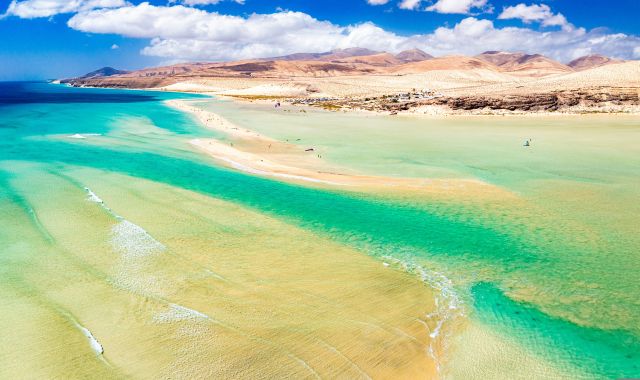
The turquoise waters at Sotavento in Fuerteventura are unreal
Best of the best beaches in the Canary Islands
Let’s cut straight to the chase, these are the best beaches in the Canary Islands.
- Playa de Cofete (Fuerteventura): a wild, remote stretch of golden sand backed by cliffs and wild Atlantic waves, more “nature’s masterpiece” than beach club.
- Playa de Las Conchas (La Graciosa): crystal-clear turquoise waters meet soft pale sand in a scenic bay with minimal development, ideal if you want your beach day to feel like an escape.
- Playa de Papagayo (Lanzarote): fine sand, protected turquoise sea, with a bit of off-road access to add a twist of adventure to stunning beach.
- Playa de Las Teresitas (Tenerife): long golden sand beach near Santa Cruz with calm waters and palm-lined shores, for that classic Canarian vibe.
- Maspalomas Dunes & Beach (Gran Canaria): soft dunes that roll into a wide beach and gentle sea make this a favorite for sweeping views and relaxed beach time.
- Playa de Nogales (La Palma): remote, dramatic and beautiful, this beach is all about the black volcanic sand, rock backdrop and strong waves.
- Playa de Santiago (La Gomera): a quiet coastal village beach, with darker sand and generally calm waters, making it the perfect spot to escape the busy resorts.
- Charco Azul (El Hierro): a stunning natural pool carved into volcanic rock, with calm, crystal-clear water for safe swimming, even if there’s no wide sandy shore to stretch out on.
Beaches in Tenerife
From golden sandy bays to wild black-sand coves, the beaches are the perfect starting point for planning a weeklong adventure in Tenerife.
Playa de Las Teresitas
Las Teresitas in Tenerife has soft golden sand that feels great underfoot and calm, protected water that’s perfect for floating without being smacked in the face by Atlantic waves. It’s an easy-going beach, with palm trees, showers, and cafés close by, which explains why locals love it so much. As you might expect, it gets busy on weekends, so claiming your perfect towel spot may require a bit of strategy.
Playa del Duque
Playa del Duque is Tenerife’s polished, upscale beach where everything feels clean, well-kept and pleasantly pampered. The golden sand is soft, the water is usually calm enough for relaxed swimming and the surroundings are filled with chic hotels, shops and cafés. It’s not wild or remote, but if you enjoy convenience with your sunshine, you’ll be very happy here.
Playa Benijo
Benijo is the moody, dramatic, “take the photo now before the tide comes in” kind of beach, with black sand and steep cliffs that look straight out of a fantasy film. The waves here can be strong, and the sand is coarser than elsewhere on the island, so it’s more about soaking in the scenery (and maybe watching surfers) than leisurely swimming. Bring snacks and water, because facilities are as limited as the shade.

All beach roads lead to Las Teresitas!
Beaches in Gran Canaria
Between sweeping dunes, family-friendly bays and hidden coves, Gran Canaria’s coastline truly has a bit of everything, and you can easily fit these spots into any Gran Canaria itinerary.
Playa de Maspalomas
In Gran Canaria, Maspalomas is famous for its soft, golden dunes that look like they’ve wandered in from an entirely different continent. The beach itself is wide and great for long walks, with generally calm water close to shore, although the area around the dunes can get breezy. It’s a popular spot, so expect plenty of people, but the sheer size means you can still find your own peaceful corner.
Playa de Amadores
Amadores is the “resort postcard” beach: pale imported sand, clear warm waters and a sheltered bay that keeps waves gentle enough for stress-free swimming. It’s ideal for families, sun-lovers, and anyone who appreciates not being exfoliated by windblown sand. Because it’s surrounded by restaurants and cafés, it’s one of the easiest full-day beach spots on the island.
Playa de Güigüí
Remote, challenging to reach, but totally worth it if you want nature over crowds: this is Güigüí. While getting there can be a bit of an Odyssey, rougher access means fewer people, so it’s perfect for those days when you just want to stretch out under the sun. The sand here is soft and underfoot feels good, but the sea can be rough. Don’t forget to pack some drinks and snacks, as there are few facilities and shops nearby.

The epic Maspalomas dunes and beach in Gran Canaria
Beaches in Lanzarote
There are so many amazing beaches in Lanzarote, it can be challenging where to start, so to make life easier, these are 3 best ones to definitely check out:
Playa de Papagayo
Papagayo is a gorgeous crescent of fine sand with water so clear you can practically count your own toes from the surface. The bay is sheltered, which keeps the sea calm and great for swimming or snorkelling, although the breeze can make the water feel refreshing. Getting to this Lanzarote beach involves a bumpy dirt road and brings the satisfaction of reaching a hidden gem that still feels natural and unspoiled.
Playa de Famara
A huge arc of soft sand with dramatic cliffs behind it, Famara feels like the kind of beach where you could accidentally join a surf school just by walking past. The wind is a frequent guest here, which keeps the waves lively and the water a bit cooler than other parts of the island. It’s an amazing place for long walks and surf watching, but swimmers should stick close to shore because the currents can be stronger than they look.
Playa del Caletón Blanco
Playa del Caletón Blanco is one of Lanzarote’s most surprising beaches, with pale sand and natural lava pools that fill with warm, calm water during low tide. The sand feels silky on your feet, and the black-and-white contrast makes every photo look like an ad for paradise. It’s fairly remote, so bring snacks and whatever beach gear you rely on, because nature here provides beauty but absolutely no conveniences.
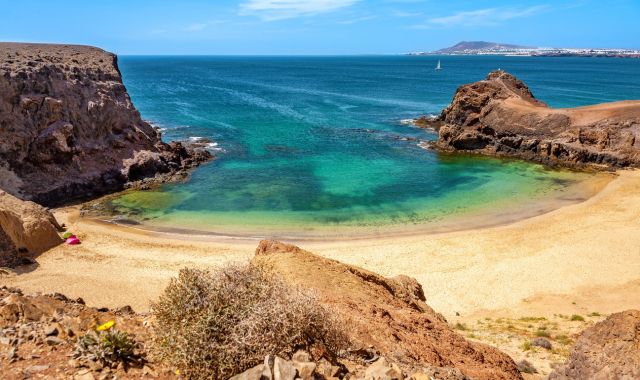
Getting to Papagayo is part of the experience
Beaches in Fuerteventura
Fuerteventura is all about long sandy stretches, shallow lagoons and steady winds, making its beaches a paradise for sunbathers, swimmers and water sports enthusiasts alike.
Playa de Cofete
Cofete on the southernmost tip of Fuerteventura is the definition of “worth the bumpy road”: a massive, untouched beach with soft sand and jaw-dropping mountains behind you. The Atlantic currents here does not mess around, so swimming is more about careful dipping than full laps. Most days, you’ll share the place with only a handful of humans and a lot of wind, giving you that dramatic end-of-the-world feeling in the best possible way.
Sotavento
Sotavento is famous for its long, shallow lagoon that forms with the tides, creating warm, ankle-deep water perfect for paddling or lazy floating. When the wind is calm, it’s a dreamy beach for relaxing, but when the breeze picks up it turns into a kite-surfer playground and your towel may try to take flight. The sand is soft and fine, so even strolling around barefoot feels great.
Corralejo Grandes Playas
A sweep of golden dunes meets clear turquoise water, making Corralejo Grandes Playas one of the most “holiday postcard” beaches on Fuerteventura. The sea usually feels a little warmer here than on more exposed coasts, and the entry is gradual so it’s easy for families and nervous swimmers. It’s more developed than the wilder beaches, so you get comforts like sunbeds and cafés without sacrificing the natural beauty.
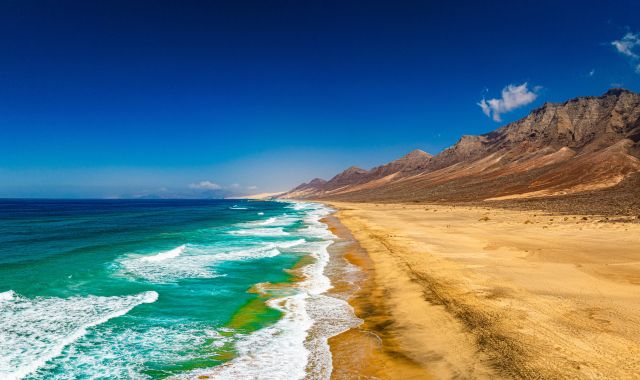
Kick back and enjoy the view at Cofete
Beaches in La Palma
Despite being the smallest of the group, La Palma is considered the most picturesque of the Canary Islands, so of course the beaches are so ridiculously stunning you’ll start questioning your life choices for not visiting sooner.
Playa de Nogales
Black volcanic sand, rugged cliffs, and often crashing waves give Playa de Nogales in La Palma a dramatic personality that’s perfect for nature lovers. The sand is surprisingly soft despite its dark, volcanic origin, and the walk down is part of the adventure. Swimming can be tricky when the swell is up, so this is one of those beaches where you happily admire the power of the Atlantic from a dry towel.
Puerto Naos
A wide, easygoing black-sand beach with a pleasant seaside promenade, Puerto Naos is designed for simple, comfortable beach days. The sand gets hot in summer, so flip-flops become your best friends, but the waters are usually calm enough for relaxed swimming. It’s more built-up than most La Palma beaches, which means you don’t have to pack your entire life into a backpack to enjoy it.
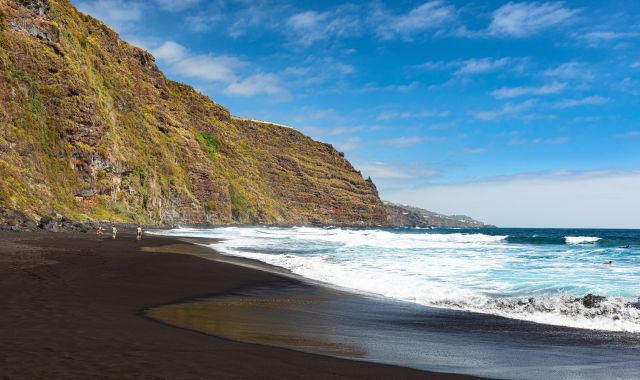
Playa de Nogales is one of the most striking beaches in La Palma
Beaches in La Gomera
La Gomera’s beaches are quieter and more low-key, framed by cliffs and green valleys, perfect if you like your sea swims with a side of peace and dramatic scenery.
Playa de Santiago
Located next to a small, mellow fishing village, Playa de Santiago in La Gomera mixes darker sand with smooth pebbles and calm waters. It’s a great spot if you like your beaches peaceful but not completely isolated, and you’ll find cafés and shade just steps away. The sea is warmer here than on the north coast, which makes it especially nice for long swims.
La Calera & Vueltas
Everybody likes a 2-for-1 deal, right? La Calera and Vueltas are twin beaches in Valle Gran Rey, one of La Gomera’s most scenic valleys and have a laid-back vibe that travelers fall in love with. The sand is a softer volcanic mix and the sea tends to stay calm, especially near Vueltas, where the bay is sheltered. Sunsets here are nothing short of legendary, so even if you don’t swim much, you’ll feel like you’re starring in a nature documentary by early evening.

Waves craching on the beach of Playa de Santiago in La Gomera
Beaches in El Hierro
El Hierro swaps endless sandy strips for characterful coves and natural pools, with clear waters, volcanic rock formations and some of the best snorkeling spots in the Canary Islands.
Charco Azul
Located on the northern side of El Hierro, Charco Azul is a natural volcanic pool carved into the rocks, with vibrant blue water that stays calm even when the ocean outside is having a tantrum. The water is clear and refreshing rather than warm, but it’s perfect for a safe dip without worrying about waves. There’s no sand here, but the platforms make it easy to get in and out, and the setting is dramatic in that “this could be my screensaver” way.
La Restinga
A small volcanic-sand beach next to one of the best diving areas in the entire archipelago, La Restinga has clear water and a friendly, relaxed vibe. The sea is usually calm and warm enough for comfortable swimming, and the nearby marina restaurants make post-beach meals dangerously tempting. It’s not a huge beach, but what it lacks in size it makes up for with charm and excellent snorkeling opportunities.
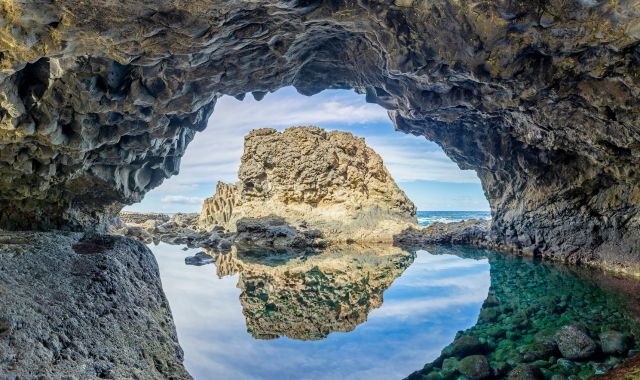
There are volcanic caverns to explore at Charco Azul
Beaches in La Graciosa
The beaches of La Graciosa feel like nature cranked the beauty settings to maximum, forgot to turn them back down, and just let the island keep them:
Playa de Las Conchas
Easily one of the most beautiful beaches in the Canaries, Playa de Las Conchas in La Graciosa stands out for its soft pale sand and an unreal shade of turquoise waters. The waves can be strong and the current feisty, so it’s more of a “stare at the beauty and take photos” beach than a long-swim spot. The sand feels soft and powdery underfoot, but bring supplies because there’s zero shade and zero facilities, it’s pure Canarian wilderness.
Playa Francesa
With calm, clear and shallow waters, Playa Francesa is perfect for an easy dip, especially compared to the wilder north side. The sand feels fine and pleasant, and boats often anchor nearby because the bay is naturally sheltered. It’s close enough to Caleta del Sebo to walk, so it’s popular without ever feeling chaotic.
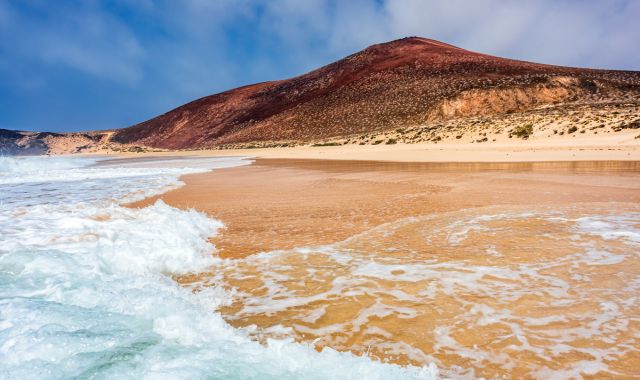
The impressive Montana Bermeja from Playa de Las Conchas
Canary Islands beach tips
- The weather in the Canaries is generally mild and consistent, but winds can be strong, especially Fuerteventura and Lanzarote. A quick look at the forecast can save you from spending the day chasing your towel across a dune.
- If you want to bring along your four-legged buddy for a swim, there are plenty of amazing dog-friendly beaches in the Canary Islands to choose from.
- It might not come as a surprise, but volcanic beaches with black sand get hotter than your breakfast toast, so pack flip-flops if you’re heading to places like Benijo, Nogales, or Puerto Naos. The good news: the texture is usually soft and surprisingly pleasant once it cools down.
- The water may look tranquil, but currents can be sneaky, especially on wild beaches like Cofete, Güigüí, Famara, and Nogales. To be on the safe side, avoid venturing too far out and swim where locals swim.
- The Canary sun is friendly until it isn’t. The trade winds can trick you into thinking you're not burning, so sunscreen, hats and long hydration breaks are your best allies.
- Bring a pair of water shoes, as some beaches, like Francesa, Santiago, and parts of Grandes Playas, have rocky patches when the tide is out.
- Pack snacks and water when visiting remote beaches, such as Cofete, Las Conchas, Güigüí, Caletón Blanco, as they have zero facilities.
- Parking can be its own adventure and popular beaches like Las Teresitas, Amadores and Papagayo fill up fast, especially on the weekends. Go early if you want easy parking and a prime spot for your towel kingdom.
- Famara, Valle Gran Rey, Amadores and Maspalomas are known for their dreamy sunset views. Bring a light jacket because the evening breeze often picks up, but the show is absolutely worth it.
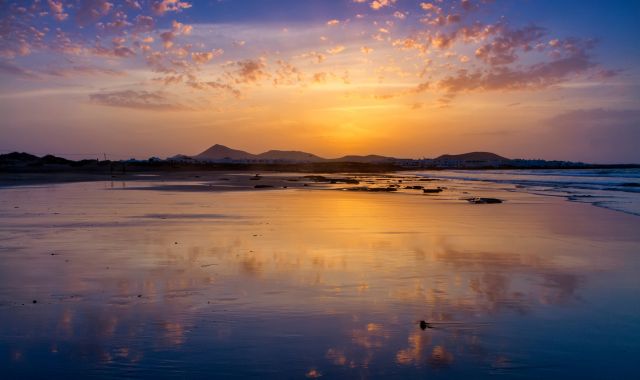
Sunsets are especially magical at Famara beach in Lanzarote
How to island-hop the Canaries to explore more beaches
Getting to the Canary Islands by ferry is straightforward, with ferries from Cádiz and Huelva regularly setting sail all year round. For more details on how you can get there, check out our guide on Spain to Canary Islands ferry schedules.
Keep in mind that the distances between most of the islands are generally short, so you can easily experience more of what the archipelago has to offer. All you need to do is take a look at our island-hopping in the Canaries guide, and you can start planning the beach holiday of a lifetime!
Book Canary Islands ferry tickets online
Have you packed your towel and sunscreen? Then all you need to do is get your ferry tickets to the Canary Islands! Check out our Map of ferries, where you can visualize your trip, compare routes and prices and book your Canarian beach adventure in just a few clicks!
Author Bio
Hi, hi! 🌞 I'm Marta, a freelance translator, the Spanish voice of Ferryhopper, a committed yogini, and a proud—and a bit obsessed—dog owner. This is why my days are a happy balance of words, my mat and walks in nature.
As I enthusiastically advocate for the superiority of ferry travel over flying (trust me, it's THE way to go!), I'm also busy plotting my next maritime adventure with my beloved greyhound. ⛵🐾